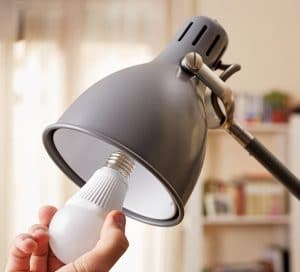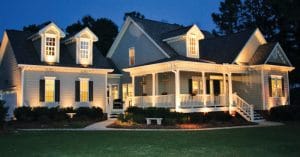 LEDs have emerged as a formidable lighting solution over the past decade due to their precise and clear lighting capabilities – which is why architects and planners are opting for them. These lights have now evolved to a stage that’s very close to imitating the spectrum of daylight. Biologically-effective LED lighting, which stabilises our biorhythms, is already being widely used across the globe.
LEDs have emerged as a formidable lighting solution over the past decade due to their precise and clear lighting capabilities – which is why architects and planners are opting for them. These lights have now evolved to a stage that’s very close to imitating the spectrum of daylight. Biologically-effective LED lighting, which stabilises our biorhythms, is already being widely used across the globe.
By Baishakhi Dutta
Reports indicate that homes can save ₹ 4,850 annually by replacing just five of their most frequently used bulbs with Energy Star LED variants. LEDs can cut down energy consumption tremendously—by 25 per cent to 80 per cent—and last three to 25 times longer when compared to conventional incandescent or CFL bulbs. The initial cost for LEDs is higher than that of any conventional light categories, but since they require negligible maintenance, the operational and replacement costs are very low, which ensures a good return on investment in the long run. LEDs also offer a wide selection of colours and brightness levels for buyers.
Latest technological innovations
The lighting industry has always been very dynamic. Some of the latest trends are listed below.
Healthy lighting: All of us would like to keep the environment healthy and bright by using the best resources. So people are focusing on using such lights at work and at home. Key lighting manufacturers, too, are offering brands that promote ‘healthy lighting’.
No wires: LED lights also have ‘no wire’ variants. In fact, lights with no wires are the latest trend these days. Users can now control these smart lights via a tablet or a smartphone. Such lights are easy to install and replace, while being comparatively long lasting.
Smart connectivity: Lights that are controlled via the Web are the new entrants in the industry. For example, if you are sitting in a particular room and wish to turn off the lights in another room, you can do so by installing lights that can be controlled by an app on your smartphone.
Inbuilt light sources: LED lighting fixtures today come with irreplaceable light sources, mainly because they last long and do not need to be replaced as often as conventional bulbs. These variants come in different sizes and styles.
New and innovative designs: The LED market is very vast. Geometric lighting fixtures are amongst the hottest lighting trends now. These lights invoke a minimalist effect and are not used just for modern and contemporary interiors.
Vimal Soni, director, Corvi LED Light, adds, “Automation is leading the way. Intelligent, human-centric lighting is becoming popular.”
Choose quality products
There are many LED products on the market; however, they are not all built the same. To ensure that the product purchased is safe to use and has been tested by an independent laboratory, look for the UL or ETL mark on the product or on its packaging.
Due to the generally long lifetime of LED products, the warranty should be for at least three-five years. Though this is a long time, do keep your receipts for proof of purchase in case the product fails prematurely. Read the product label carefully. The following specifications should be clearly outlined:
- Light output (lumens)
- Power consumption (watt)
- Lumens per watt (efficacy)
- Colour accuracy (CRI > 80)
- Colour temperature (kelvin should be stated as a number, i.e., 2700K, not just warm white or cool white)
It’s important to ensure that these LED lights are produced by an established manufacturer in India, who has a good reputation and an extensive marketing set-up in all major towns of the country. “Ideally, LED lighting should be procured directly from well-known companies or from their established dealers and distributors, who can promptly attend to any technical issues,” says V.P. Mahendru, managing director, EON Electric Ltd.
Soni believes that lumens per watt (LPW) is an important specification for customers to base their purchase decision on, since it indicates whether the lights are efficient. He also feels that the warranty should be considered as a mark of quality and durability.
Suggestions to domestic buyers
“Choose well-known retailers of electrical lighting products, preferably authorised stockists or distributors of an established company,” says Mahendru. According to Soni, “Since lighting is one of the central aspects of a person’s home or office environment, buyers ought to get more involved in the buying process and make informed decisions before purchasing.”
Rambo Zhang, general manager, Opple Lighting India Pvt Ltd, says, “Being trendy is the new thing. Consumers looking for the best lighting solutions should consider the trends in the industry.” He adds, “The LED residential lighting market in India is very vast and offers different products that suit almost all the major requirements of the consumers. Indian consumers want high quality products at a comparatively low price.”

The road ahead
Soni believes that intelligence as a trend in lighting will continue to grow. As consumers get more aware and lean towards informed buying, products with real features, compared to cheap offerings, will excel. Zhang says that though LED technology was a costly affair initially, with the passage of time and developments in technology, these lights have become cheaper. With governments encouraging people to cut their energy usage, LEDs can contribute towards sustainable energy consumption.
Zhang adds that conserving energy is one major aspect that the LED light companies are aiming for. These companies keep on creating new and innovative lights that are suitable for the Indian consumer and are pocket-friendly. Over the last few years, the use of LED bulbs and streetlights has shot up in homes, offices and on roads all over the world. Converting conventional lights to energy-efficient LED lighting leads to cost and energy savings, and a lower reliance on fossil-based fuels, he says.

































